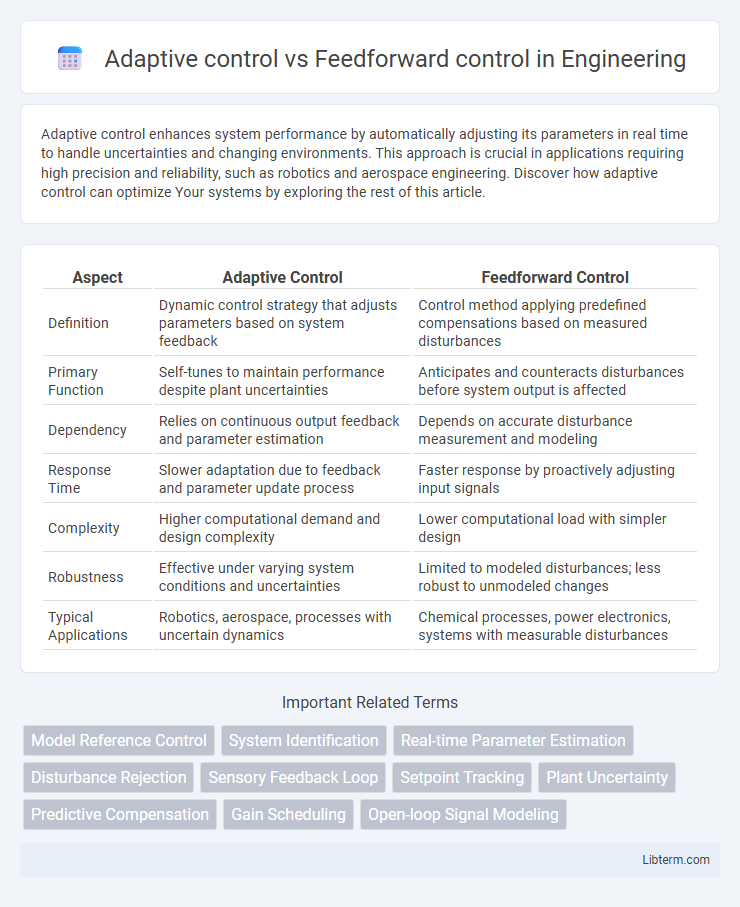Adaptive control enhances system performance by automatically adjusting its parameters in real time to handle uncertainties and changing environments. This approach is crucial in applications requiring high precision and reliability, such as robotics and aerospace engineering. Discover how adaptive control can optimize Your systems by exploring the rest of this article.
Table of Comparison
| Aspect | Adaptive Control | Feedforward Control |
|---|---|---|
| Definition | Dynamic control strategy that adjusts parameters based on system feedback | Control method applying predefined compensations based on measured disturbances |
| Primary Function | Self-tunes to maintain performance despite plant uncertainties | Anticipates and counteracts disturbances before system output is affected |
| Dependency | Relies on continuous output feedback and parameter estimation | Depends on accurate disturbance measurement and modeling |
| Response Time | Slower adaptation due to feedback and parameter update process | Faster response by proactively adjusting input signals |
| Complexity | Higher computational demand and design complexity | Lower computational load with simpler design |
| Robustness | Effective under varying system conditions and uncertainties | Limited to modeled disturbances; less robust to unmodeled changes |
| Typical Applications | Robotics, aerospace, processes with uncertain dynamics | Chemical processes, power electronics, systems with measurable disturbances |
Introduction to Adaptive and Feedforward Control
Adaptive control continuously adjusts control parameters in real-time based on system performance and environmental changes, enhancing robustness in uncertain or varying conditions. Feedforward control anticipates disturbances by using model-based predictions to apply corrective actions proactively, improving system response and accuracy. Both strategies optimize control systems, with adaptive control focusing on learning from feedback and feedforward emphasizing preemptive adjustments through system modeling.
Core Principles of Adaptive Control
Adaptive control continuously adjusts system parameters in real-time to maintain optimal performance despite uncertainties or changing conditions. It relies on feedback mechanisms and parameter estimation algorithms to modify control laws dynamically, ensuring robustness and stability. This contrasts with feedforward control, which anticipates disturbances without real-time parameter updates.
Fundamentals of Feedforward Control
Feedforward control operates by anticipating disturbances and adjusting the control input accordingly, relying on a precise mathematical model of the process to predict system behavior. This proactive strategy enhances system stability and performance by compensating for known disturbances before they affect the output. Unlike adaptive control, which continually adjusts parameters based on feedback, feedforward control uses predefined control actions derived from the process model to achieve desired results.
Key Differences Between Adaptive and Feedforward Control
Adaptive control continuously adjusts controller parameters based on real-time feedback to handle system uncertainties and dynamic changes, while feedforward control uses a fixed model to anticipate disturbances and apply corrective actions before errors occur. Adaptive control excels in environments with unknown or time-varying dynamics, whereas feedforward control relies on accurate system modeling and known disturbance measurements. The core difference lies in adaptive control's feedback-dependent parameter tuning versus feedforward control's proactive, model-based disturbance rejection.
Advantages of Adaptive Control Systems
Adaptive control systems offer the advantage of real-time parameter adjustment, enabling them to maintain optimal performance despite changes in system dynamics or external disturbances. Unlike feedforward control, which depends on predefined models and may struggle with unanticipated variations, adaptive control continuously learns and adapts, enhancing robustness and accuracy. This dynamic adjustment capability is crucial for complex or nonlinear systems where precise modeling is challenging.
Benefits of Implementing Feedforward Control
Feedforward control improves system responsiveness by anticipating disturbances and adjusting inputs proactively, reducing error before it occurs. This method enhances stability in dynamic environments and minimizes reliance on feedback loops, leading to faster correction times and improved overall performance. Implementing feedforward control increases process efficiency and precision, especially in complex systems with measurable disturbances.
Limitations and Challenges of Adaptive Control
Adaptive control faces significant challenges such as computational complexity and the need for accurate real-time parameter estimation, which can lead to instability if system dynamics change rapidly. Limitations include sensitivity to measurement noise and time delays, which can degrade performance and slow adaptation speed. Unlike feedforward control, which relies on predefined models and lacks self-correction, adaptive control requires robust algorithms to handle uncertainties and maintain system stability in varying environments.
Drawbacks Associated with Feedforward Control
Feedforward control struggles with inaccuracies due to model uncertainties and external disturbances that are not predicted, reducing its effectiveness in dynamic environments. The lack of feedback in feedforward systems makes real-time error correction impossible, leading to potential instability or performance degradation. Additionally, designing a precise feedforward model is complex and requires extensive knowledge of the system dynamics and disturbance characteristics.
Practical Applications: Adaptive vs Feedforward Control
Adaptive control excels in environments with significant uncertainty and dynamic changes, such as autonomous vehicles and robotics, by continuously adjusting parameters based on real-time feedback. Feedforward control is effective in systems with predictable disturbances and known dynamics, like industrial temperature regulation and chemical processing, where preemptive corrections improve response time. Practical applications benefit from combining both methods to enhance stability and accuracy, especially in aerospace and manufacturing automation.
Choosing the Right Control Strategy for Your System
Adaptive control dynamically adjusts system parameters in real-time to handle varying operating conditions and uncertainties, making it ideal for systems with unpredictable environments or parameter changes. Feedforward control anticipates disturbances by measuring them before they affect the system, providing fast corrective action without relying on feedback, best suited for systems with known and measurable external inputs. Selecting the right control strategy depends on system complexity, disturbance predictability, and the need for real-time adjustment versus preemptive correction.
Adaptive control Infographic

 libterm.com
libterm.com